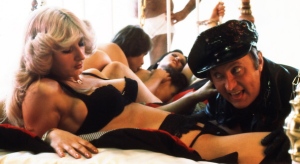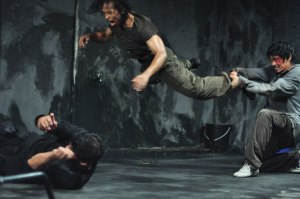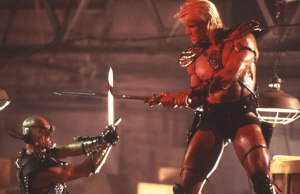Ratings: Fast and Furious, 3/5; Fast and Furious 5, 5/5; Fast and Furious 6, 4/5
Who’d have thought, fourteen years ago, that the fairly low-budget, kind-of exploitation movie Fast and Furious would have spawned six sequels, with another three to come? Now one of the hottest franchises around, part 7 promises to be ridiculous, and ridiculously entertaining – albeit tainted by the sudden death of Paul Walker in a real car accident. How they’ll deal with this remains to be seen, and how the series copes with the loss of one of its lead actors will largely depend on what direction the writers choose to take it. In advance of part 7’s release, however, I watched parts 4-6 – the revamped, rebooted portion of the franchise, following the less memorable Tokyo Drift. Back to back, it was a great afternoon/evening and, by the end of it, Vin Diesel had become one of my favourite bad actors. Bless his cotton socks, he tries. He really does – you can see the effort in every heartfelt scene, every moment of conflict. He so clearly takes his craft so seriously, but no matter what inner turmoil the character’s going through, none of it translates. He is the man with one face – blank, stoic, an empty void. Yet I can’t help but enjoy his performances, particularly when they’re watched one after the other. Somehow this franchise has survived despite the fact that I’m fairly certain neither of the leads (and most of the ensemble cast around them) can act.
And it’s not just about the cars. The F&F movies have succeeded for a few key reasons. One, the characters are simple and unremarkable, but they’re all likeable and, to the writers’ credit, each one has their own distinctive personality – however unimaginative and lacking nuance – and they all spark off each other well. I can’t even complain about the women, who hold their own while looking smokin’ hot. Two, the action sequences – of which there are many – are dynamic, explosive, absurd, and thoroughly engaging. These are such macho movies, but they’re not alienating, and that’s quite impressive really. Three, the cars themselves are a thing of beauty, if you’re that way inclined, and there’s something for every afficionado, from American muscle cars, to hot hatches, and even some proper supercars. Needless to say, everything’s really shiny. Four, Dwayne Johnson is now most definitely part of the F&F “family”. More on him in a bit. And finally – perhaps even more importantly than the inclusion of The Rock – these films are just plain fun. They do exactly what they say they’re going to: fast cars, fast driving, furious action, full-on entertainment. Having moved beyond the original street-car themes, these movies are now straight-up action, and all the better for it.
Although each film in the series does fit into the F&F universe, it’s the last three that have really moved directly on from each other – part 4 even finishes on a cliffhanger that opens part 5. Part 4 is good, but it’s nothing compared to 5, when all hell breaks loose in Rio and Dwayne Johnson turns up to out-Vin-Diesel Vin Diesel. Sporting a tough-guy goatee and some serious muscle, Johnson is the actor Vin Diesel can never hope to be – bigger, stronger, and infinitely more charismatic. Whereas Vin Diesel appears to think he’s starring in the next hard-hitting think-piece, Johnson knows full well where he is: slap-bang in the middle of a world where the laws of gravity no longer apply, where criminals are good guys but bad guys are super bad, where jail never really seems to be a possibility and money is rarely an issue. This is a world like the one that James Bond inhabits, where the bad guys’ cars instantly implode on impact, but the good guys can be taken out by trucks and walk away unscathed. It’s a world where, somehow, everyone seems to have a licence to kill, and no qualms about using it, where law enforcement is fully aware of this fact but does nothing, and there are absolutely no repercussions whatsoever following the majority of Rio being taken out by a giant runaway safe. Simply put, it’s my kind of world.
There is a risk, of course, that the films will become stupid in their efforts to outdo themselves, and it’s already happening. Part 6 is a step down after the glorious stupidity and hugely entertaining heist scheme of part 5 – there’s more action, less story, more ass-kicking, less attention to physics, less The Rock, more London. By the time the plane started taking off on the runway, signalling the beginning of one of the most ludicrous final scenes in recent cinema memory (experts claim the runway must be almost 30km in length, exceeding the world’s longest by almost 25km), I had completely lost track of why they were there in the first place. Something about an international terrorist and a bunch of top secret “components”? Not that it really matters much – who cares about plot when you’ve got a tank taking out innocent drivers on a Spanish motorway, a street race through Piccadilly Circus, and a bad-guy plane (you know what that means!)? Well, in truth, me – a little bit. Part 6 is fun, don’t get me wrong, but it doesn’t quite get the balance right. So it goes like this: Part 4 is them finding their feet (wheels?); Part 5 is them in their prime; Part 6 is trying just a bit too hard. As for Part 7? Well, the trailer looks pretty epic – and I expect nothing less.









